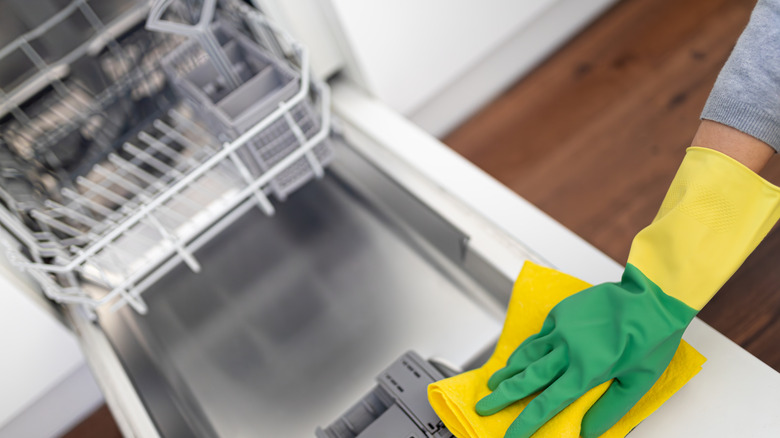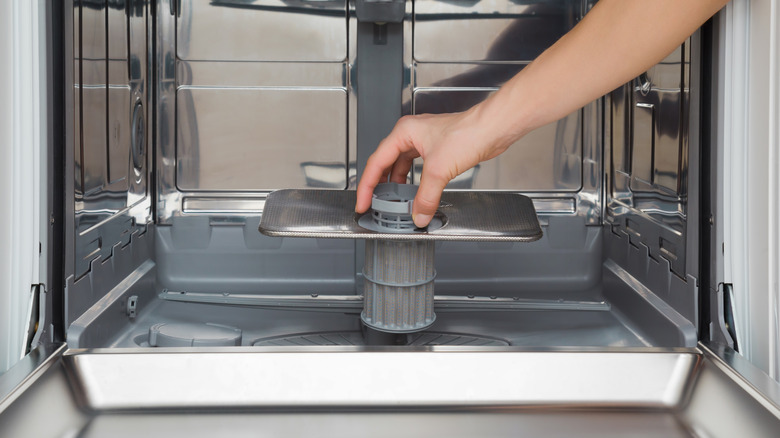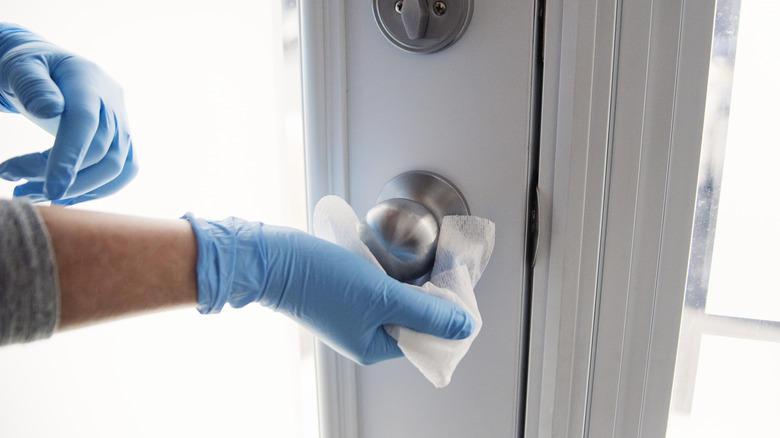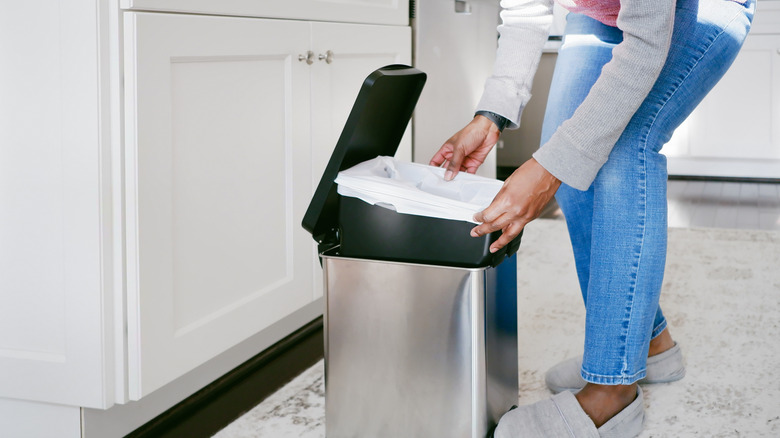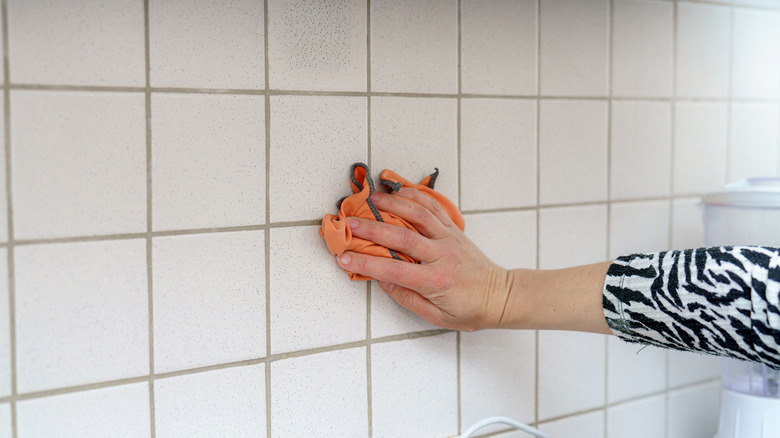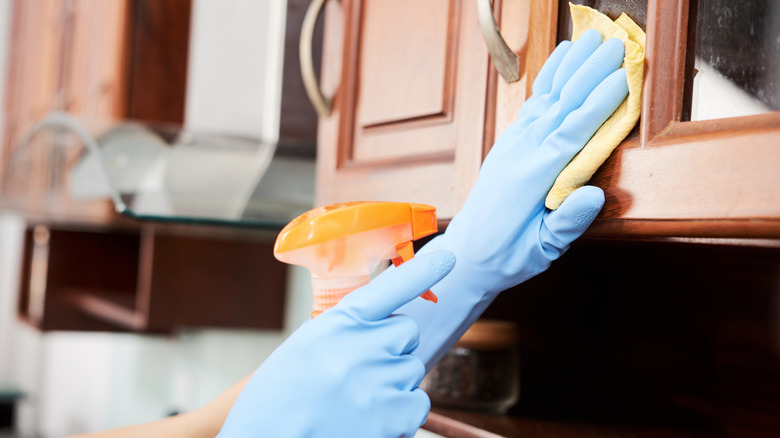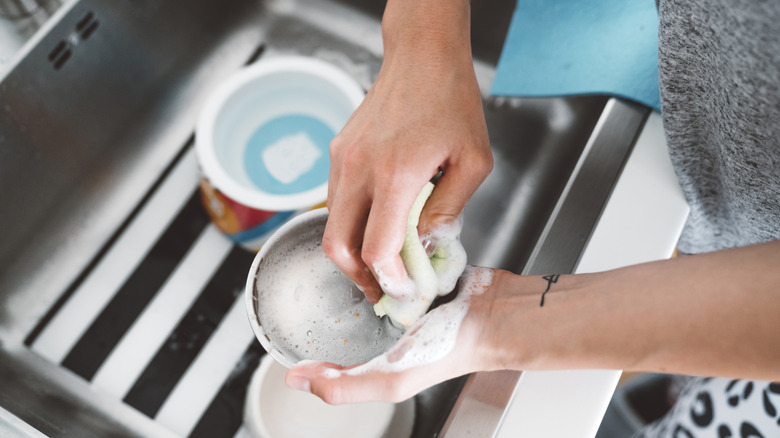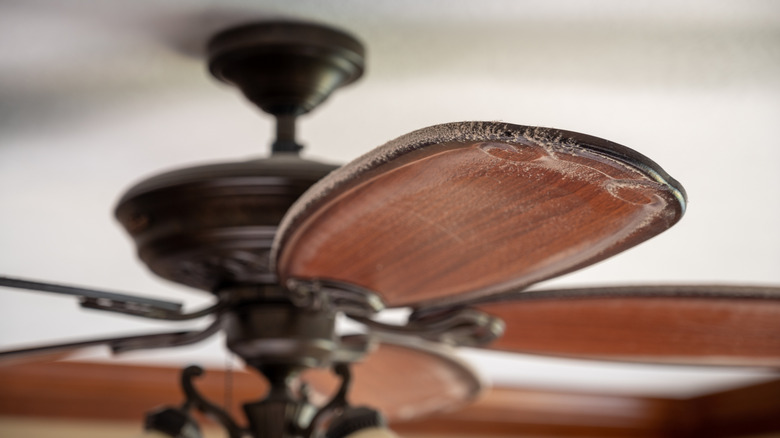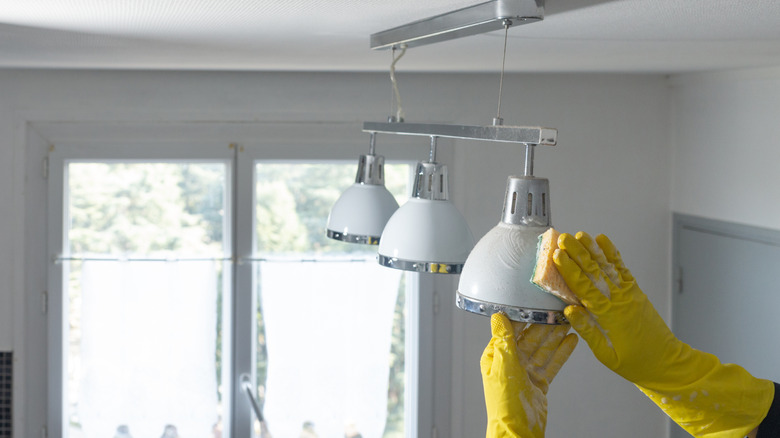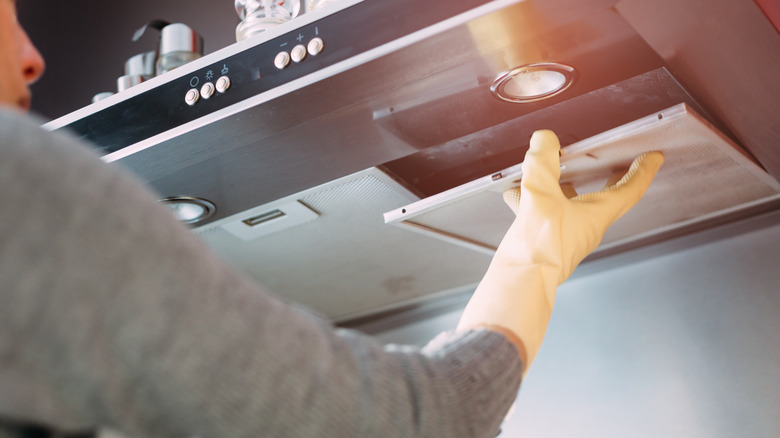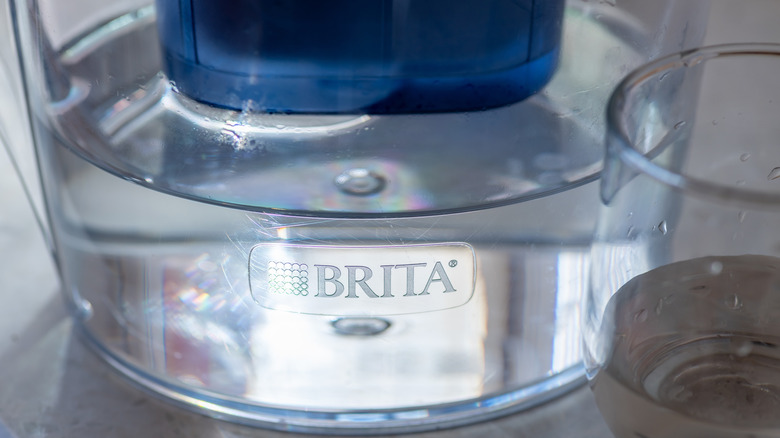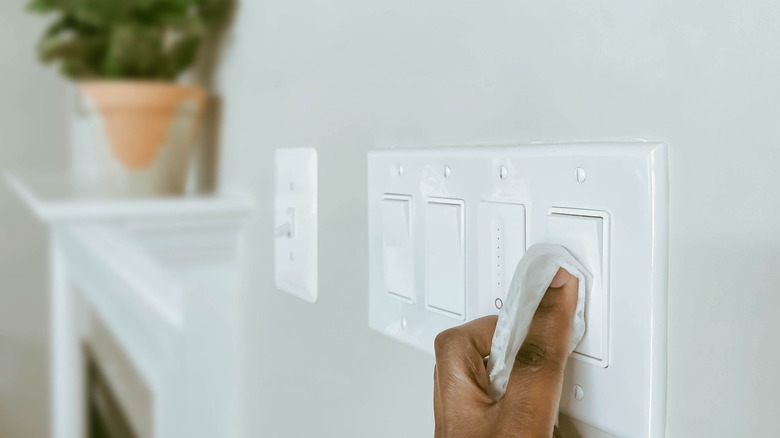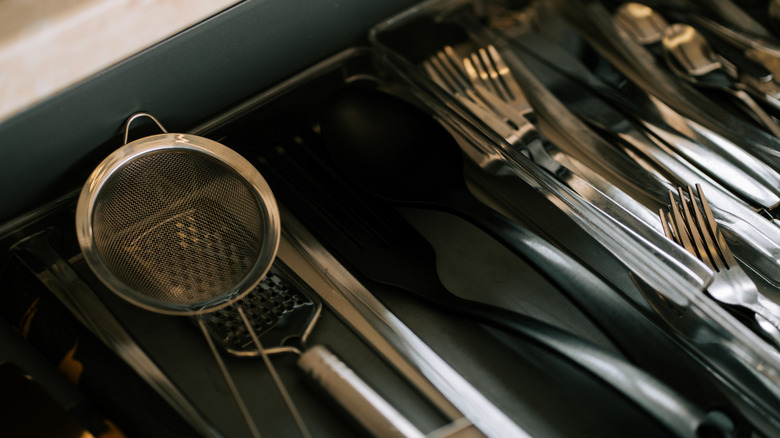12 Dirty Spots Hiding In Your Kitchen That You Should Be Cleaning
While we all know to clean our kitchens daily, ideally after each use, there are some spots that often go unnoticed or avoided. Every day, we should at least be wiping down the counters and doing the dishes, making sure our sinks don't build up with food scraps and odors. Besides those daily chores, however, there are a few sneaky spots in your kitchen that you may be overlooking or forgetting entirely, including your trash can, door knobs, backsplash, and the inside of your dishwasher. Not only do these areas experience buildup, but they can also add to any foul odors wafting through your home.
High-traffic areas and any well-used surface of your kitchen, especially is used to store food or for food preparation, should be cleaned regularly. Unsuspecting areas like doorknobs, drawer handles, and cabinets can be gathering spots for dust, grease, and germs, and should be wiped down at least once a week. When planning your kitchen chore list, you can make sections for daily, weekly, monthly, and yearly tasks. You can even specify some nightly 'closing duties' to keep the room clean. Not only will your kitchen look better, but it should smell and feel cleaner.
Dishwasher
While the dishwasher does a lot of our kitchen clean-up for us, this appliance is often ignored when it comes to kitchen chores. Your dishwasher has a central filter underneath the spray arm. Using a sponge or an old toothbrush and water, scrub and rinse the filter before putting it back in place. Wipe down the inside walls of your dishwasher as well as the front for any residue. If your appliance doesn't have a self-cleaning cycle, run a regular cycle with a cup of white vinegar on the top rack monthly.
Doorknobs
Germs and bacteria are not exclusive to just doorknobs in public spaces; they can be found in your home as well. Depending on the type, bacteria on a doorknob can survive for anywhere from four hours to five months, and doorknobs can be even more contaminated than toilets. In your kitchen, you should be sanitizing your doorknobs and handles at least once a week, if not daily. You can wipe them down first with hot water and soap before sanitizing with a disinfecting spray or wipe. Make sure to let the surfaces sit and dry completely before using.
Trash cans
If there's a lingering odor in your kitchen, chances are it's your trash can. No matter how often you take out your trash, the can itself can become a home to spills, crumbs, and food, making it a kitchen cleaning priority. After removing any contents, rinse out the bottom of the can to get rid of lingering scraps. Using a disinfecting spray or a DIY solution of vinegar, dish soap, and water, scrub the inside and outside. Next, rinse the can and let it dry completely before adding in another bag. Deep clean your kitchen trash can weekly.
Backsplash
You might not think to deep clean your kitchen's backsplash, but this area can get exceptionally dirty. Depending on where you have a backsplash, whether it's behind your stovetop, sink, or countertops, these high-traffic surfaces are prone to stains, food residue, and oils. Take warm water and soap to the area to remove any grime that has been trapped in and around the material. If you have a tile backsplash, you can purchase a tile-specific cleaner and allow the solution to sit and soak before wiping it off. Ideally, you should deep clean your kitchen backsplash at least weekly.
Cabinet shelves
You might not think that your kitchen cabinets would need a deep clean, but these areas can get pretty grimy, both inside and out. If you look closely, the doors are most likely stained with food residue or dust, and the shelves can be even worse. Your specific cleaning method will depend on your cabinet's material, though it's recommended that you dust or vacuum first. If you have wooden cabinets, you can use an all-purpose cleaner, making sure to get into the nooks and crannies. Ideally, you should give your kitchen cabinets a deep clean every few months.
Pet bowls
According to the National Sanitation Foundation, pet bowls are the fourth dirtiest item in the home after kitchen sinks, sponges, and toothbrush holders. Especially if you keep your pets' food and water bowls in your kitchen, these items need to be on your deep cleaning list. Even if these containers just sit on the floor, they can still create grime and unwanted odors, so it's important to keep them clean as well. For the benefit of their health, pets should have clean water and food bowls. Some experts recommend cleaning out their bowls daily with soap and water.
Ceiling fans
If you have a ceiling fan in your kitchen, add this spot to your monthly deep clean to-do list. Your fan can get covered in grime, making it a potential hazard to the food you prepare underneath. Plus, a ceiling fan won't work as efficiently when it's dirty. Before cleaning it, make sure to turn your fan completely off. A helpful trick to avoid spreading the grime and dust over your kitchen is to use an old pillowcase to swab the blades clean. Insert the case onto each blade and wipe, letting the dust fall into the case.
Light fixtures
In the same vein as ceiling fans, any lighting fixtures hanging in your kitchen can become a breeding ground for dirt and dust, which can easily settle onto your food prep and dishes. Believe it or not, food particles and grease from cooking can also end up on these surfaces, depending on where they are located in the space. To safely clean these areas, turn off the lights and use a microfiber cloth to wipe down both the bulbs and the fixtures. It's recommended to wipe down these areas at least once a month if not weekly.
Range hood
Chances are, you've probably noticed a thin film of grease coating your stove's range hood. This high-traffic area can get pretty covered with splatters, thanks to its close contact with your stovetop. In order for the range hood to keep working to clear the air properly, it needs to be cleaned regularly. Use a grease-cutting spray to wipe down the exterior and under the hood. Make sure to remove the filter, soak it in hot, soapy water, and scrub until clean.
Water dispensers
It shouldn't be a shock to hear that you should deep clean your filtering water containers at least a few times a month, and definitely whenever you change out the filter. The latter can depend on the instructions of your pitcher's manufacturer. Some experts recommend washing out these pitchers completely at least once a week to avoid any mold or bacterial growth. This includes removing the filter, taking apart the pitcher, and washing it with warm, soapy water. Allow the pitcher to completely air dry.
Light switches
Light switches should already be on your weekly chore list, but your kitchen switches specifically might need a little extra TLC. High-traffic surfaces like these can easily get covered in bacteria and grime, especially when in your kitchen, where you are handling food. You won't want to accidentally infect yourself with E. coli or salmonella simply because you touched a light switch. First, turn off the outlets or switches from your circuit breaker. Remove the light switch cover and wipe it with warm water and soap. Make sure the cover is completely dry before putting it back on.
Silverware drawer
Despite the fact that the silverware drawer is only supposed to hold clean utensils, it can still become a gathering place for crumbs and dust. It's recommended to clean your utensil drawer at least once a month to avoid any excess buildup. To do this, you can either use a handheld vacuum or remove the organizer entirely, letting it soak in a combination of warm water and soap. If crumbs are a big issue in your kitchen, you can find organizers that come with a crumb tray underneath, making it easy to clean up.
